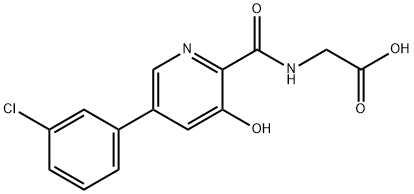COMPUTED DESCRIPTORS
| Molecular Weight | 306.70 g/mol |
|---|---|
| XLogP3 | 2.5 |
| Hydrogen Bond Donor Count | 3 |
| Hydrogen Bond Acceptor Count | 5 |
| Rotatable Bond Count | 4 |
| Exact Mass | 306.0407345 g/mol |
| Monoisotopic Mass | 306.0407345 g/mol |
| Topological Polar Surface Area | 99.5 Ų |
| Heavy Atom Count | 21 |
| Formal Charge | 0 |
| Complexity | 393 |
| Isotope Atom Count | 0 |
| Defined Atom Stereocenter Count | 0 |
| Undefined Atom Stereocenter Count | 0 |
| Defined Bond Stereocenter Count | 0 |
| Undefined Bond Stereocenter Count | 0 |
| Covalently-Bonded Unit Count | 1 |
| Compound Is Canonicalized | Yes |
PRODUCT INTRODUCTION
description
One of the most common symptoms of advanced renal disease is anemia, caused primarily by the inability of the kidney to respond to anemic conditions with a corresponding increase in [erythropoietin] (EPO) production. Treatment of anemia of chronic kidney disease (CKD) has traditionally involved the administration of exogenous erythropoiesis-stimulating agents (ESAs), such as [darbepoetin alfa], to counter the decrease in endogenous EPO production. While efficacious, the overuse of ESAs has been associated with cardiovascular complications, progression of CKD, and increases in overall mortality. A relatively new and alternative treatment option for patients with anemia of CKD are small molecule inhibitors of hypoxia-inducible factor prolyl-hydroxylase (HIF-PH). These agents inhibit prolyl-hydroxylase domain oxygen sensors, which essentially mimics hypoxic conditions and activates hypoxia-inducible factor, a transcription factor that serves a multitude of roles, including the stimulation erythropoiesis. Vadadustat is an orally administered inhibitor of hypoxia-inducible factor prolyl-hydroxylase (HIF-PH) which is currently approved in Japan for the treatment for anemia due to CKD in both dialysis-dependent and non-dialysis dependent adult patients, and is currently awaiting a regulatory decision by the FDA for the same indication. The safety and efficacy of vadadustat have been shown to be non-inferior to darbepoetin alfa in patients with anemia of CKD undergoing dialysis, but it did not meet the prespecified noninferiority criterion for cardiovascular safety in a similar study in patients with non-dialysis-dependent CKD.

